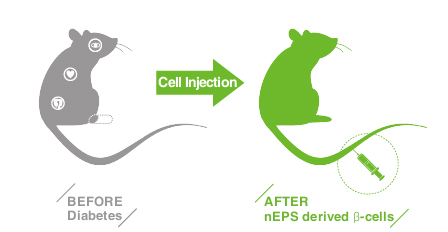Stem Cell Treatment & Research Institution
Diabetes:
Our goal is to cure the diabetes using differentiated beta cell from nEPS.
So far, STRI research team hasconductedan experiment with cell pouch composed of nEPS cells and beta cells
The results demonstrated that nEPS and nEPS differentiated beta cells can improve glucose level in diabetes.
What we have achieved so far:
– STRI has studied type I diabetes (STZ-induced diabetic mouse) with nEPS transplant to regulate glucose levels with 426 follow-up days.
– Transplanted nEPS group regenerated pancreatic beta-cell islet.
– STRI has studied type II diabetes (db/db mouse) with nEPS injection to check the decrease of glucose level.
Diabetes Program
Diabetes mellitus has no permanent cure to date. One of the plausible therapeutic strategies to achieve this goal is through pancreatic stem cell transplantation. Various stem cell sources and manipulation techniques can be used to generate functional β-cells safely and efficiently. And in this respect, we believe nEPS cell technology possesses the potential of becoming an alternative strategy for generating insulin-producing cells in a relatively harmless and practical way. We proved the generation of functional pancreatic β-cells in both in vitro and in vivo studies.
We successfully developed a highly efficient differentiation protocol for human pluripotent stem cell differentiation that yielded functionally β-cells resembling those of adult human pancreatic β-cells. The successful differentiation demonstrated by in vivo insulin gene and protein expressions.
Intravenous Cell Injections:

The transplanted nEPS-derived β-cells were able to survive within the tissue environment where they were engrafted. Moreover, our data from a preliminary study on a cohort of STZ-induced diabetes mellitus mice models demonstrated a promising result as following IV (intravenous) transplantation of nEPS-derived β-cells, decreased glucose level was observed.
Transplantation of Cell Pouch:

Cell pouch contains pancreatic β-cells differentiated nEPSs that its proprietary structure releases insulin into the blood vessel and optimizes cell survival with oxygen and nutrient supply from the blood vessel.
The utilization of the cell pouch makes it easy to formulate blood vessels between lattice structures. These vessels are also able to prevent the attack of immune cells.
The spheroid formation of pancreatic β-cells improves the survival rate of the cell and increases effectiveness of insulin secretion.
Confirmed the effect of blood glucose regulation on diabetes:

Collaboration Research with Surgery and Pathology departments of Bundang Seoul National University Hospital